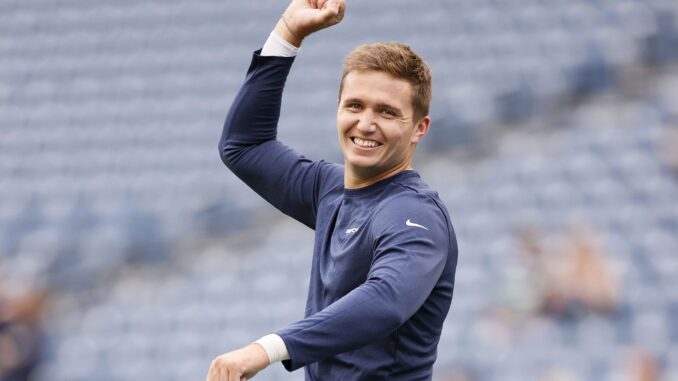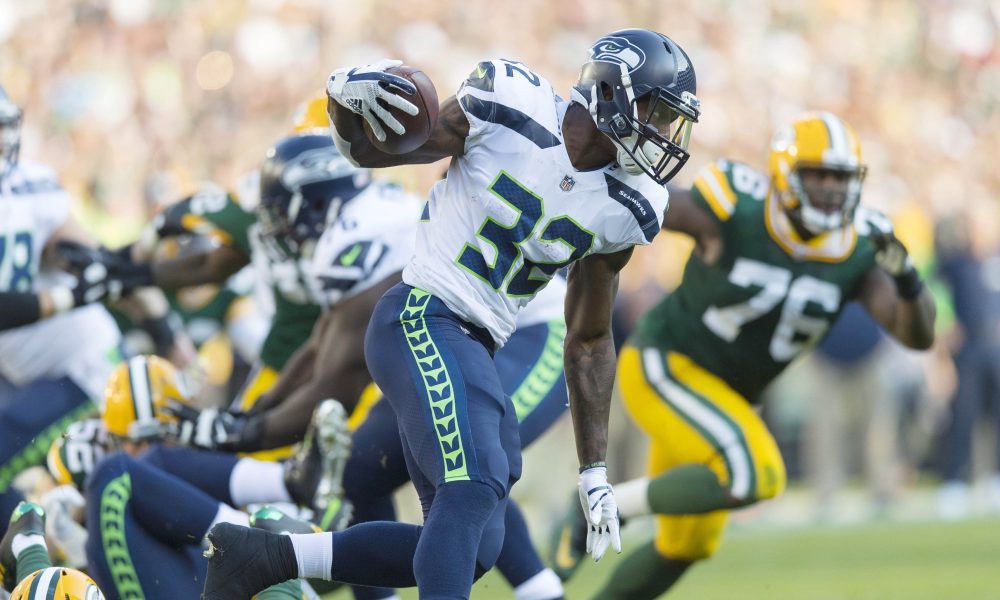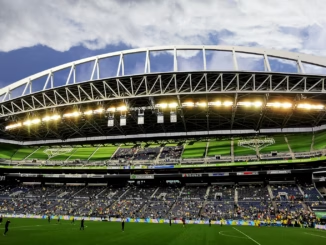
Last week, the people made their case against Seattle’s new QB. If you missed those arguments, you could find them here. Today we will hear the defense’s case and their arguments.
What we know about Drew Lock is that he seems to have his best seasons in his second year in a new system, which is pretty consistent with what we see from other QBs around the league. That first year is a lot to learn and tends to come with growing pains during the season as the offense finds its way against a different defense most weeks.
Even if Seattle ends up retaining Lock next year, they will also need to retain offensive coordinator Shane Waldron so that the two can work together for two consecutive seasons. A player rarely thrives while learning and leading a new system, but by year two, they are usually comfortable in it as long as that system works.
In Lock’s sophomore season at Mizzou, he played under first-year coordinator Josh Heupel, throwing for 3400 yards with 23 touchdowns to just 10 interceptions in twelve games. In year two in Huepul’s system, Lock threw for 3960 yards with 44 touchdowns and just 13 interceptions in 13 games. For his senior season, Lock worked with first-year coordinator Derek Dooley. Lock played well, throwing for 3500 yards with 28 touchdowns against just 8 interceptions in 13 games. He increased his completions as well as completion percentage, but his yards per attempt dropped an entire yard and a half on average from the previous season, which indicates a lot more checkdowns or screens vs. pushing the ball down the field a lot more the previous season. Lock also had 12 more rushing attempts as a senior and increased his rushing touchdowns from one his junior year to 6 as a senior.
Lock’s revolving door at OC didn’t end when Denver drafted him, and the Broncos made extremely limited attempts to help Lock to succeed. Lock started out learning first-year OC Rich Scangarello’s system (it was also his first time calling plays at the pro level) and was listed behind Joe Flacco, who the Broncos had traded for to provide veteran support for Lock. Flacco started the first eight games before being injured, and then Lock and Brandon Allen split the remaining games. Lock performed well, going 4-1 in five games as the starter while throwing for 1000 yards and seven touchdowns against three interceptions. Following the season, Scangarello was fired and replaced by Pat Shurmur.
Before we get into how Lock did in his first season under Shurmer, let’s look at Shurmur’s past success. He’s been around the league since 2002 and has worked for several teams. Shurmur is credited with developing Donovan McNabb, which is interesting since McNabb was already a pro bowl player before Shurmer arrived in Philadelphia. His actual accomplishments as a QB guru are working with rookie Sam Bradford with the Rams in 2010 and second-year QB Nick Foles with the Eagles in 2013. In between Bradford and Foles, Shurmur worked with Colt McCoy in 2011, helping him get the most success so far in his now decade-long career. Shurmur was still there in 2012, but McCoy was not the starter. Shurmur was fired after two poor seasons and went to the Eagles again, where he worked with Foles and helped develop him into a starter for one season before he missed out on being hired as the head coach. Rather than stay on, he left for Minnesota, where he found one season of success with Case Keenum at QB. Shurmur was hired by the New York Giants to be their new head coach in 2018 and spent two years there. He worked with rookie QB Daniel Jones in 2019, with Jones having an up and down season. Shurmur led the team to 9 total wins in two seasons before being fired. He was then hired as the new OC in Denver to work with second-year QB Drew Lock.
Shurmur got one decent season each out of Sam Bradford, Nick Foles, Colt McCoy, Case Keenum, and Daniel Jones. Maybe some folks would call that a successful QB guru; I think he knew how to get young QBs to make quick reads and get the ball out of their hands. It didn’t translate to long-term success for any of them because it didn’t teach them how to adapt and elevate their game or read defensive coverages. So even if you apply McNabb’s great career to Shurmur, he has one success story followed immediately by a list of four failures and at least two young players with the jury still a few years out. This list doesn’t even include the strange case of 28-year-old rookie Brandon Weeden who Shurmur coached for one season in Cleveland. It should come as no surprise that Weeden had a decent rookie year and then failed to succeed after that. Quick fixes often result in long-term issues and broken confidence for young quarterbacks.
Lock’s second season in Denver and first under Shurmer was an up and down affair. Lock started 13 games, going 4-9 while throwing for nearly 3000 yards and 16 touchdowns against 15 interceptions. Not great numbers, but guys have done worse in Shurmur’s system, so it’s not bad either. In his second season with Shurmur, Lock was asked to compete with veteran Teddy Bridgewater for the starting spot, and Bridgewater was eventually listed at the top of the depth chart in front of Lock. Bridgewater played well but not great in his only season in Denver and signed with Miami in the offseason. Lock played well in six total games, starting three times, but we would like to have seen what he could have done with the majority of a season in his second year in the system.
Lock will turn 26 this season and has only played in 24 games TOTAL in three seasons. For context, he’s played the same amount of games and is the same age (25) Russell Wilson had played by the midway point of his second season as a starter. That’s a young player with a ton of runway in front of him if he wants to make a long career out of it. At this point in his career, Wilson had 134 games left between the 9th game in his second season and the 17th game in his 10th season.
Lock has very low miles for a player entering his 4th season, has had to learn two systems already, is currently learning a third, and has played with something like 30 different pass catchers in that span. By the time he starts an entire season, he might be the most experienced first-year starter ever. He’s already made the rookie mistakes, the second-year mistakes, and the third-year mistakes. He’s a very young veteran QB that can only get better.
With a future HOF QB in Wilson for most of last season, Seattle won 7 games, had a losing record for the first time in Wilson’s career, missed the playoffs, and finished last in their division. Wilson is without question one of the greatest players ever at his position, but it’s also possible he is in a sudden decline. So this idea that they took a huge step backward from Wilson to Lock is kind of silly. It won’t be hard for Lock to improve on seven wins, but it will be tough to do worse. In his only season starting the majority of the games, he won four of them, so to ask him to win at least three more wouldn’t be crazy, but the expectation is that he can get at least 8 or 9 wins and go into next season with a lot of team confidence and a run at being something special.
There are plenty of reasons to believe Lock is the guy in Seattle not just this season but going forward. His supporting cast in Denver was very talented, but the team didn’t win many games. His supporting cast in Seattle should be better, and the little we know about his new offensive coordinator is that he prefers a balanced system that uses the run to open the pass, which is very helpful to all QBs, but especially young QBs learning to read defenses. When you can establish the run, you can use play-action to freeze linebackers and safeties for half a second, which could be long enough to get a big play going. And it forces the defense to stay honest and not load the box against RBs, forcing the QB to beat them in single coverage against a blitz.
The people used Lock’s stats against him, but the defense is going to use other players’ stats for him, and you get to be the deciding vote.
Below are the best seasons a primary receiver has had; each of them has played with Lock at some point in his career.
Choose two to play alongside Lock this season.
Receiver A- 72 receptions, 1112 yards, 6 touchdowns
Receiver B- 83 receptions, 1303 yards, 10 touchdowns
Receiver C- 100 receptions, 1054 yards, 10 touchdowns
Here are some secondary receivers and their best seasons, choose one to pair with Lock this year.
Receiver D- 52 receptions, 856 yards, 3 touchdowns
Receiver E- 31 receptions, 218 yards, 0 touchdowns
Receiver F- 68 receptions, 670 yards, 4 touchdowns
Now choose two college running backs to pair with Lock in the backfield.
Running back A- 1636 yards, 18 touchdowns
Running back B- 2248 yards, 23 touchdowns
Running back C- 1140 yards, 19 touchdowns
Running back D- 2587 yards, 29 touchdowns
Now check out the answer key below and find out who you chose to team with Lock this year and if any of them are his current teammates. You were asked to select 5 players; if 3 or more of them are Seattle players, then you must agree that the offense in Seattle is better suited for success than the one in Denver was. The defense has argued that the coaching staff in Denver was not capable of helping Lock, and we’ll have to see if the system in Seattle will be good for him.
So what it comes to is which team has the better offense for Lock to run? And it’s up to you to decide.
Answer Key
Primary receivers’ best seasons
Receiver A- Courtland Sutton
Receiver B- DK Metcalf
Receiver C- Tyler Lockett
Secondary receivers’ best seasons
Receiver D- Jerry Jeudy
Receiver E- Tim Patrick
Receiver F- Noah Fant
College running backs
Running back A- Kenneth Walker III
Running back B- Rashaad Penny
Running back C- Javonte Williams
Running back D- Melvin Gordon III




